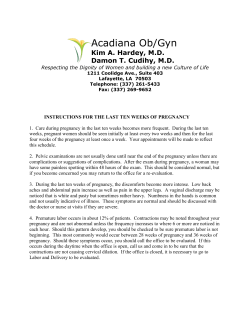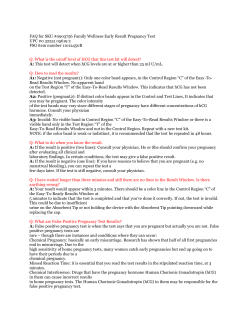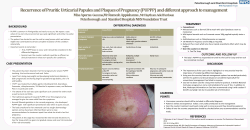
WHAT IS THE RIO TINTO CHILD HEALTH PARTNERSHIP?
Official Newsletter of the Rio Tinto Child Health Partnership Delivering improvements in Aboriginal and Torres Strait Islander Child and Maternal Health August 2006 WHAT IS THE RIO TINTO CHILD HEALTH PARTNERSHIP? This innovative collaboration brings together the research expertise of Kulunga Research Network and the Telethon Institute for Child Health Research with corporate partners Rio Tinto Ltd and the AER Foundation, and government partners through public sector agencies in Western Australia, Queensland and the Northern Territory. This ambitious partnership aims to deliver improvements in Aboriginal and Torres Strait Islander maternal and child health by translating research findings into policies and health promotion programs that make a real difference to Indigenous communities. The first outcome of the Rio Tinto Child Health Partnership has been the translation of the WA Aboriginal Child Health Survey (WAACHS) to Queensland and the Northern Territory, an important and significant step to achieving nationally consistent indicators of Aboriginal and Torres Strait Islander health. The WAACHS is the first cross-sectional study of its kind to investigate the health of Aboriginal children, and has produced a comprehensive set of indicators of Indigenous child health. More information about the WAACHS can be found at www.ichr.uwa.edu/waachs, or on the WAACHS Fact Sheet. Another program of work undertaken through the Partnership is looking at ways to prevent tobacco and alcohol consumption during pregnancy, the principle causes to low birth weight births and fetal alcohol spectrum disorder. Findings through the WAACHS indicate around 50 per cent of pregnant women used tobacco, and almost one quarter of women drank alcohol during their pregnancy, figures that suggest contemporary health promotion messages are not cutting through to Indigenous women. Using health promotion and action research approaches, trial communities across the three states have developed resources designed to reduce and prevent substance use during pregnancy. The final program of work involves developing an Indigenous maternal and child health workforce. An important and successful outcome in Queensland is the development of a unique train-the-trainer resource to help health care professionals train community workers in promoting maternal and early infant health. The Rio Tinto Child Health Partnership is a useful demonstration of how corporate, government and research agencies can work together to deliver outcomes in health. More information about the Rio Tinto Child Health Partnership can be found at www.ichr.uwa.edu.au/ kulunga, or by contacting Colleen Hayward, Partnership Manager on 08 9489 7777. A MESSAGE FROM THE MANAGER This edition of Partnership News heralds a new era for the Rio Tinto Child Health Partnership. In the past, the successes of the Partnership have been largely kept within the Partnership itself. The highly successful symposium Start Out Strong: A healthy beginning in life, provided the perfect stage to share news and information about the Partnership and the work it is undertaking. The level of interest from across jurisdictions and sectors clearly signalled the need for better engagement and communication between all parties working in the field of improving health outcomes for Aboriginal and Torres Strait Islander children. Delegates to the symposium indicated their interest in learning more about the Partnership and in being kept updated on its developments. I therefore welcome the new readership of Partnership News and look forward to us all working together. Colleen Hayward Partnership Manager Start Out Strong: A healthy beginning in life The urgent need to improve the health and well-being of Indigenous children was the focus of a two day national symposium held in Perth on the 9th and 10th May 2006. The START OUT STRONG: A healthy beginning in life symposium, was hosted by the Rio Tinto Child Health Partnership, an initiative of the Telethon Institute. Chair of the Partnership, Professor Fiona Stanley said the symposium looked at ways to promote healthy pregnancy, and would highlight programs that are achieving results in three major areas: • • • Reducing substance use during pregnancy Improved nutrition, including breastfeeding The first years of life. “It’s so important that Aboriginal mothers and families are empowered with information and supported with adequate resources so they can make good choices to improve the on-going health of their babies.” Professor Stanley said. Professor Stanley said it was appalling that Indigenous children in Australia continued to suffer much higher rates of infant mortality and poor health including low birth weight, chronic infections and disability. As the pathways to both poor and good health start before birth and are heavily influenced by childhood factors, getting a good start is most crucial to enhance adult health as well. Over 170 delegates attended the symposium representing a range of sectors including community-based health care organisations and clinics, Indigenous communities, State and Commonwealth government agencies and leading research institutes in Australia and overseas. All the presentations were of the highest standard and covered a range of issues and experiences. Above: Over 170 delegates attended the two days of the symposium Above: Kulunga Manager Colleen Hayward and Professor Fiona Stanley The symposium was a great success and an invaluable opportunity for so many working in this important area to come together and share their success stories, expertise, research and resources. The main issues raised during the symposium have been captured in a report which also highlights the successful approaches in Indigenous maternal and child health promotion programs. The report and other information about the symposium are available on the Kulunga website at www.ichr.uwa. edu.au/kulunga. Above: International Keynote speaker, Dr Caroline Tait from Saskatchewan, Canada Preliminary discussions have commenced regarding a similar symposium for 2007, with a focus on workforce development. 2 Institute’s Alcohol and Pregnancy Project Update Consultation with the community and health professionals and the collection of information and materials about alcohol use in pregnancy are key components of a major West Australian project to address alcohol consumption in pregnancy. The effects of alcohol use in pregnancy may include physical, mental, behavioural, and/ or learning disabilities with possible lifelong effects. Fetal Alcohol Syndrome represents the severe end of the range of abnormalities which may result from alcohol use in pregnancy. The Alcohol and Pregnancy Project aims to develop ‘best practice’ health promotion material for health professionals to use when advising women on alcohol use and its effects during pregnancy in consultation with health professionals and women in the community. The Project is based on previous research which identified the need to provide health professionals with better information about the diagnosis of Fetal Alcohol Syndrome, and on advising pregnant women about alcohol use in pregnancy. Our research found that most health professionals do not enquire about or provide women with information on the consequences of alcohol use during pregnancy, and most reported their need for resources such as written material for themselves and for distribution to clients. Since the Alcohol and Pregnancy Project commenced in January, we have made a lot of progress. A Project Officer has been recruited and is working hard to gather evidence and collate national and international literature and resources on alcohol and pregnancy. This will support the production of evidence-based material for health professionals to use when addressing alcohol use in pregnancy. We have also set up an Aboriginal Community Reference Group and a Consumer and Community Reference Group to gain a community and consumer perspective on all the activities of the Alcohol and Pregnancy Project. We met with these groups for the first time in March and April, and they are already providing the Project with very valuable advice. Starting in July, we will be speaking with health professionals (Aboriginal health workers, allied health professionals, community nurses, general practitioners, obstetricians and paediatricians) about their experiences in communicating about alcohol use in pregnancy and its effects. Aboriginal and non-Aboriginal women throughout Western Australia (metropolitan and regional) will also be consulted in the next few months to explore issues relating to the communication on alcohol use during pregnancy and its effects on the unborn child. Such activities will enable us to produce ‘best practice’ health promotion material for health professionals and for health professionals to give to women to supplement their advice. The Alcohol and Pregnancy Project has been made possible by funding from Healthway and is a collaboration between researchers at the Telethon Institute for Child Health Research, Edith Cowan University, Curtin University of Technology, University of Sydney and the WA Department of Health. We’d really like to hear from individuals and organisations that have experience with or know about resources on alcohol and pregnancy for health professionals and whether the resources were of any use. Please let us know by emailing janp@ichr.uwa.edu.au. 3 Partnership Project Updates PROJECT 1: National Modelling of the WA Aboriginal Child Health Survey (WAACHS) National Modelling of the WA Aboriginal Child Health Survey involves assessing the feasibility of translating the WAACHS data on Indigenous children and their families across the three jurisdictions. The WAACHS model has potential benefits for other states/territories with high proportions of Aboriginal and Torres Strait Islander populations, notably Queensland and the Northern Territory. Resource constraints however, have meant that it is not feasible to reproduce and conduct such a large-scale study in each state. Therefore, the Institute agreed to test whether the model could be applied in, and produce similarly reliable indicators in estimate form, for Queensland and the Northern Territory. The Australian Bureau of Statistics (ABS) has found that the populations of Indigenous children in the three states within the project, namely, the Northern Territory, Queensland and Western Australia, are similar enough to enable, with application of confidence intervals. This means the project has now reached its conclusion in terms of the Partnership. This has been endorsed by the Partnership’s National Advisory Committee, membership of which includes the AER Foundation. The ABS is keen to facilitate national modelling of the WAACHS, and it is anticipated the Institute will be a collaborating partner in this process. States interested in participating include New South Wales and South Australia, and work will continue with these jurisdictions over the coming year. The Partnership’s National Advisory Committee (NAC) agreed that as the potential for further development of this project exceeds the three jurisdictions working as part of the Partnership, this project should be recognised as a significant achievement of the Partnership but that further development should occur outside the Partnership. The National Advisory Committee requested they be kept appraised of such developments. PROJECT 2: Reducing Alcohol and Tobacco Consumption in Pregnancy Project 2 is being led by the Queensland jurisdiction (Queensland Health), which is focusing on reducing prenatal exposure to alcohol and smoking, initially in three Aboriginal and Torres Strait Islander communities. In particular, Queensland Health will develop community capacity for promotion, prevention and early intervention strategies in the conception to birth stage of life. The trial sites in Queensland have specifically asked that the Partnership adopt a health promotion approach to strategies, and focus on delivering healthy outcomes for babies, including healthy pregnancy. Queensland trial site, the Inala Health Service, produced its annual calendar with this year’s focus being alcohol and smoking prevention in pregnancy. The calendar features Aboriginal women and their babies and pregnancies, as well as health information about healthy versus substance use-affected babies. The calendar has been widely distributed throughout Australia. The second Queensland trial site, The Townsville Aboriginal and Islander Health Service, has produced a series of information pamphlets that are designed to be provided to women attending the clinic. The pamphlets address smoking, alcohol and other drug use during pregnancy, and come in varying layouts and designs. Queensland Health entered into a community agreement with Kowanyama (through the Justice Group) as the third trial site for the work of the jurisdiction. Kowanyama were regarded as bringing strong community leadership to the Partnership, and in December a health promotion officer commenced in the community. The community held a baby festival, which was well-attended by community members and various government agencies. Unfortunately, due to recent changes to their core business activities, Kowanyama has since withdrawn from the project. Another appropriate trial site is currently being sought by Queensland Health. 4 PROJECT 3: National Indigenous Community Health Workforce Strategy The issue of Indigenous health worker’s role and career development is an aspect of this objective of the Partnership that the Northern Territory has also identified and will be a focus of its activities in Project 3. In early 2005 the Aboriginal Health and Families: A Five Year Framework for Action was endorsed by the NT Government. The Framework for Action commits to a program of reform to build on what has already been achieved. The focus includes a commitment to increase Aboriginal representation in the health and community services workforce to 15% over the next three to five years. Implementation of the Northern Territory Government’s Pathways to Community Control is expected to involve provision of a range of standard/core, integrated family and health services at all sites under a community controlled model. From a policy and practice point of view, this will give an increased focus on the use of different disciplines through multidisciplinary, non-hierarchical teams, as opposed to the top-down specialist medical model. A vision of the policy is trained and credentialed Indigenous Health Workers who can provide a more consistent, broader range of locally based health services. The Northern Territory believes improvements can be made on the current perception of Aboriginal health workers as an itinerant and unspecialised service delivery workforce. The Northern Territory has taken the lead in developing a set of Key Service Domains and Core Performance Indicators for Aboriginal Primary Health Care Services. There are 4 key domains of Aboriginal primary health care services requiring indicators of performance. These are: • Domain 1: Health Services (including clinical services and community health programs) Domain 2: Management & Support Services Domain 3: Linkages, Policy and Advocacy Domain 4: Community Involvement • • • Each of these domains two categories of performance indicators have been agreed: 1. Universal performance indicators that can be measured immediately; Performance indicators that can be worked towards in the future. 2. As part of the core services initiative, and as part of the ongoing work to reform workplace practices and workforce models, the OAHFSP has mapped workplace models consistent with the achievement of the principal of care at the first level of competence and the demands created by the core services agenda. The workforce model promotes greater use of integrated pathways and optimal use of staff competencies. This first model will be applied and then refined through further research and reform. 5 Changes to the Partnership Responsibility for administering the Partnership in Queensland has been moved due to a restructure in Queensland Health. The Partnership now sits in the Child and Youth Health Unit, and new staff are as follows: • • Katrina Horsley – Director Helen Luyendyk - Principal Policy Officer The Institute must acknowledge the support and assistance of the former headed by Madonna Cuthbert, and including Gerry Cleary, Sandra Tulk, Shaun Edwards-Kalk and Audrey Deemal. Changes within the Kulunga Team at the Institute have seen Dr Clair Scrine assume the executive coordination duties for the partnership following the April 2006 departure of Ms Rani Param, who left her position at the Institute to pursue her graduate studies. Associate Professor Ted Wilkes continues as the Partnership Leader and Associate Professor Colleen Hayward continues as Partnership Manager. No changes to governance arrangements occurred in Northern Territory. Futher information For more information on the Rio Tinto Child Health Partnership, please visit our website at www.ichr.uwa.edu.au/kulunga. or contact us at: Rio Tinto Child Health Partnership C/O Kulunga Research Network Telethon Institute for Child Health Research PO Box 855, WEST PERTH WA 6872 Phone: 08 9489 7777 Fax: 08 9489 7700 To be added or removed from our mailing list, please contact us by email on enquire-kulunga.ichr.uwa.edu.au The Rio Tinto Child Health Partnership is proudly supported by: 6
© Copyright 2025



















